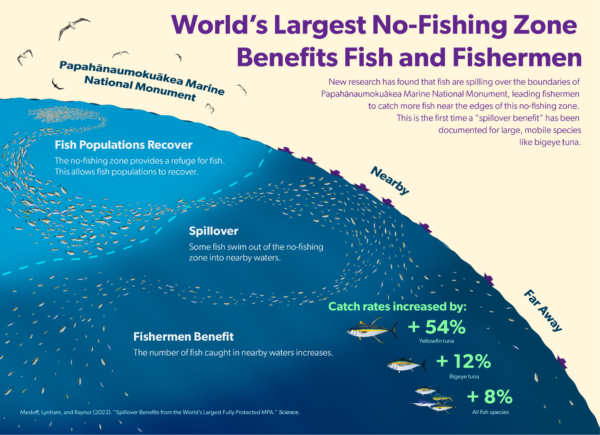A huge marine reserve in the Pacific Ocean has led to the recovery of tuna and other migratory fish around its borders. Carefully placed no-fishing zones can help to restore tunas and other large, iconic fish species, according to a study published in Science.
The Papahānaumokuākea Marine National Monument in Hawaii is almost four times the size of California. Papahānaumokuākea is the largest contiguous marine conservation area in the world. It was first created west of Hawaii in 2006 and then dramatically expanded by President Barack Obama in 2016. It now encompasses more than 582,000 square miles.
Fishing is banned inside the zone, but a spillover effect has boosted tuna stocks in nearby waters, scientists have found. It is well known that no-fishing zones can benefit sedentary marine life, such as corals or lobster. However, until now, it was assumed that no marine protected area could be big enough to protect species that travel long distances, such as tunas.
Catch rates of fast-growing yellowfin tuna increased 54% in waters near the protected zone after it was expanded dramatically in 2016. Catches of bigeye tuna, which grow more slowly, have rebounded 12% in that same period.
It’s the first time research has shown a large, well-placed no-fishing zone can help migratory species like tuna — which can travel hundreds or thousands of miles — rebound and have a “spillover” effect in fisheries nearby.
“Our hunch going into this if you’re going to see a recovery in a spillover, it’s most likely going to be an overfished species,” said John Lynham, a professor of economics at the University of Hawaiʻi at Mānoa and a lead author on the study. “But we were a little bit surprised at how quickly this was happening.”
The region is home to millions of seabirds and 7,000 species of marine life, many of which are only found in the Hawaiian Islands. All commercial fishing and resource extraction is banned within the boundaries of the monument.
The commercial fishing industry fiercely opposed the expansion of the conservation area in 2016. But Lynham said the data strengthens arguments that sustainability isn’t good just for the environment, but for fisheries too.
The story was covered extensively, including the BBC, NatGeo, ABC, Mongabay and HuffPost. The news release from the University of Hawai’i can be read here.
The study, ‘Spillover benefits from the world’s largest fully protected MPA’, published in Science can be found here.
